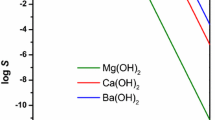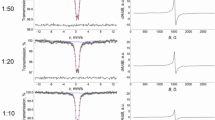Abstract
The processes of formation of iron(II) complexes in aqueous glycine solutions in the pH range of 1.0–8.0 at 298 K and ionic strength of 1 mol/L (NaClO4) are studied using Clark and Nikolskii’s oxidation potential method. The type and number of coordinated ligands, the nuclearity, and the total composition of the resulting complexes are determined. The following complex species are formed in the investigated system: [Fe(OH)(H2O)5]+, [FeHL(H2O)5]2+, [Fe(HL)(OH)(H2O)4]+, [Fe(OH)2(H2O)4]0, [Fe2(HL)2(OH)2(H2O)8]2+, and [Fe(HL)2(H2O)4]2+. Their formation constants are calculated by the successive iterations method using Yusupov’s theoretical and experimental oxidation function. The model parameters of the resulting coordination compounds are determined.
Similar content being viewed by others
References
Kh. D. Yakubke and Kh. Eshkait, Amino Acids. Peptides. Proteins (Mir, Moscow, 1985) [in Russian].
Z. N. Yusupov, G. B. Eshova, and S. S. Saidov, Dokl. Akad. Nauk RT 51 (8), 620 (2008).
Albert, A. and Sergeant, E.P., Ionization Constants of Acids and Bases (Wiley, London, 1962).
The Chemist’s Handbook, Ed. by B. P. Nikol’skii and O. N. Grigorov (Khimiya, Moscow, 1965) [in Russian].
M. M. Rakhimova, Doctoral Dissertation in Chemistry (Dushanbe, 2013).
O. V. Salishcheva, S. E. Kiselev, and N. E. Moldagulova, Sovrem. Problemy Nauki Obraz., No. 5 (2011). ISSN 2070-7428.
N. S. Osmanov, Proceedings of the All-Russia Scientific Conference (with foreign participants) “Advances in Synthesis and Complex Formation” (Ros. Peoples’ Friendshiip Univ., Moscow, 2012) [in Russian].
Redoxmetry, Ed. by B. P. Nikol’skii and V. V. Pal’chevskii (Khimiya, Leningrad, 1975) [in Russian].
M. M. Rakhimova, N. S. Yusufov, T. M. Nurmatov, et al., Am. Chem. J. 3 (2), 23 (2013).
M. M. Rakhimova, T. M. Nurmatov, N. Z. Yusupov, et al., Russ. J. Inorg. Chem. 58, 719 (2013).
M. M. Rakhimova, T. M. Nurmatov, N. Z. Yusupov, et al., Russ. J. Inorg. Chem. 58, 746 (2013).
Yu. B. Koryakin and I. I. Angelov, Pure Chemicals (Khimiya, Moscow, 1974) [in Russian].
I. M. Kolthoff, R. Belcher, V. A. Stenger, and G. Matsuyama, Volumetric Analysis (Interscience, New York, 1957), Vol.3.
G. Charlot, Les methodes de la chimie analytique: Analyse quantitative minerale (Masson, Paris, 1961).
Quick Reference Book of Physical and Chemical Quantities, Ed. by K. P. Mishchenko and A. A. Ravel’ (Khimiya, Leningrad, 1974) [in Russian].
L. V. Kvyatkovskaya, G. B. Eshova, D. A. Davlatshoeva, and M. M. Rakhimova, Vestn. TNU, Nos. 1–4, 86 (2014).
Z. N. Yusupov, RT Patent No. 295, Byull. Izobret., No. 21 (2001).
Author information
Authors and Affiliations
Corresponding author
Additional information
Original Russian Text © G.B. Eshova, J.A. Davlatshoeva, M.M. Rakhimova, L.V. Kvyatkovskaya, M.O. Guriev, 2018, published in Zhurnal Neorganicheskoi Khimii, 2018, Vol. 63, No. 4, pp. 525–530.
Rights and permissions
About this article
Cite this article
Eshova, G.B., Davlatshoeva, J.A., Rakhimova, M.M. et al. The Effect of Concentration Parameters on Complexation in the Iron(0)–Iron(II)–Glycine–Water System. Russ. J. Inorg. Chem. 63, 561–566 (2018). https://doi.org/10.1134/S0036023618040083
Received:
Published:
Issue Date:
DOI: https://doi.org/10.1134/S0036023618040083




